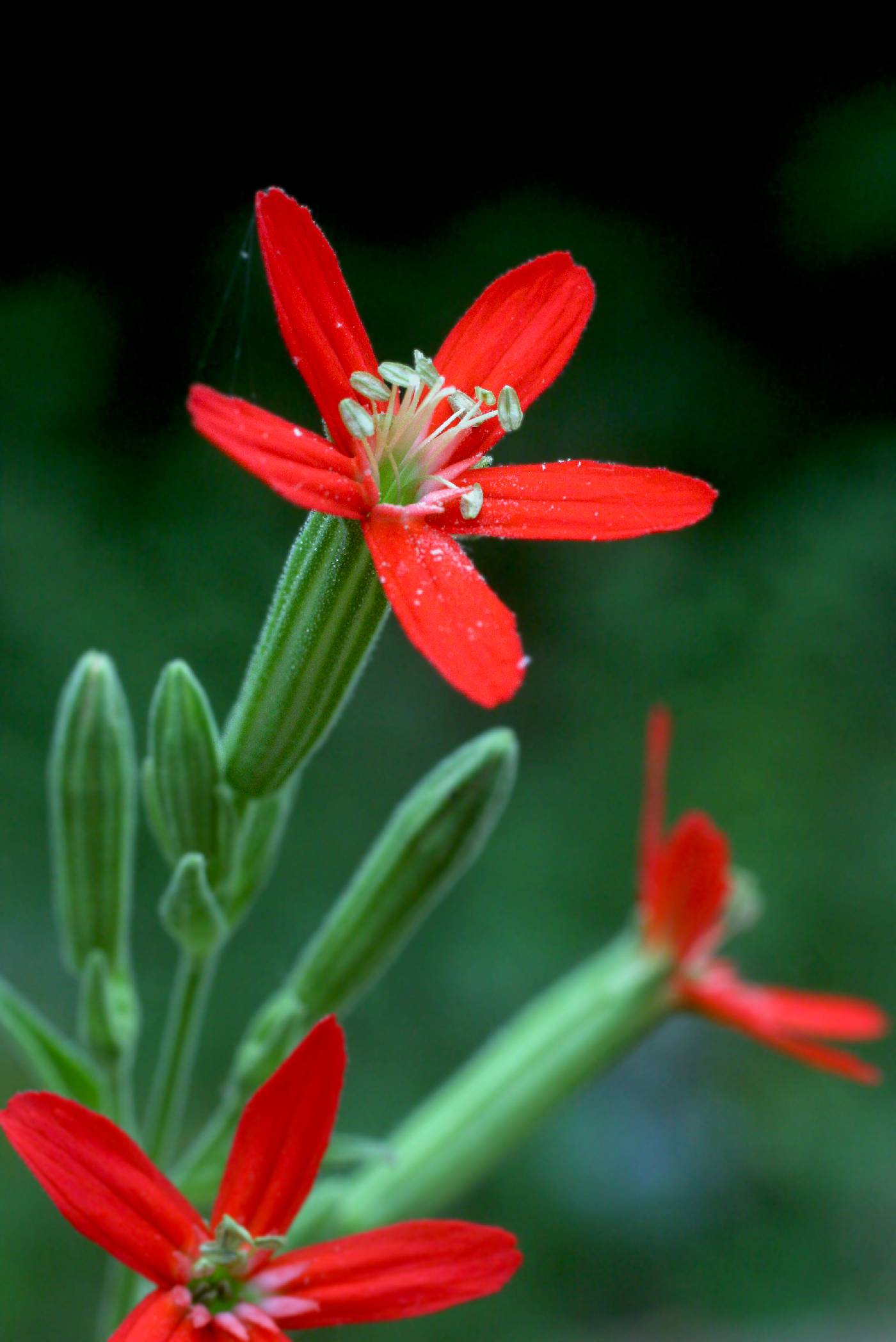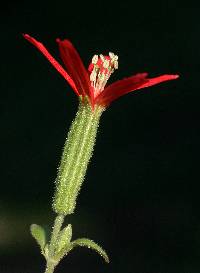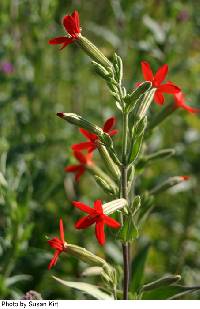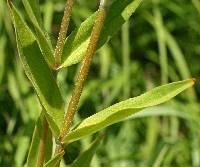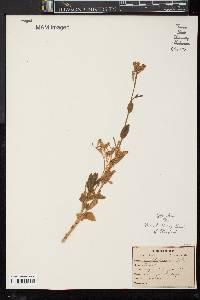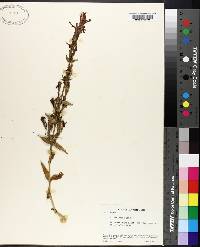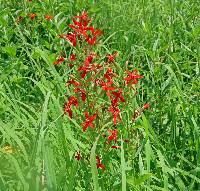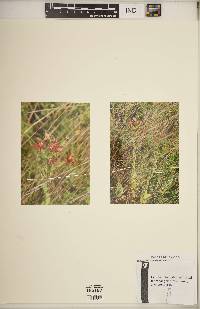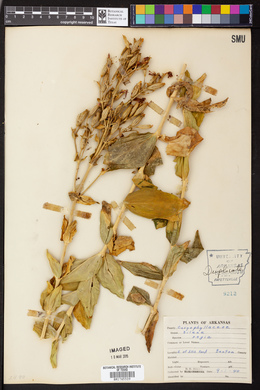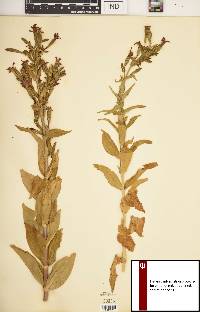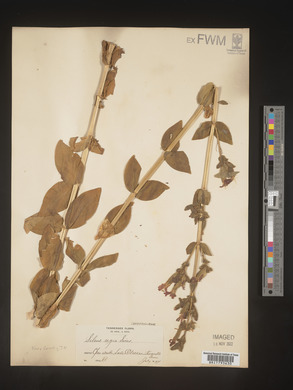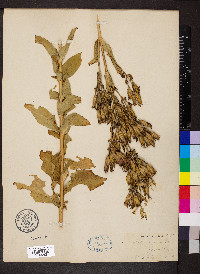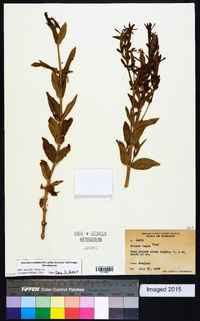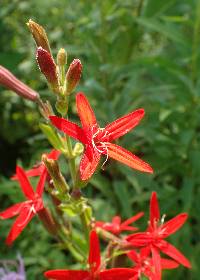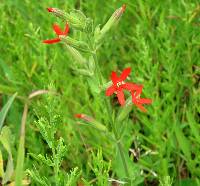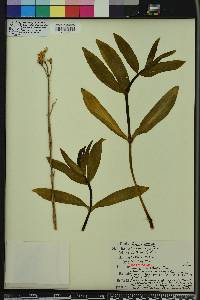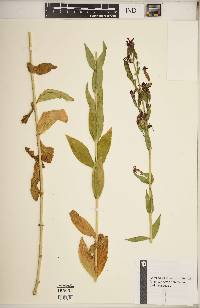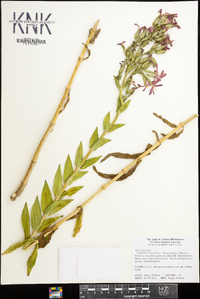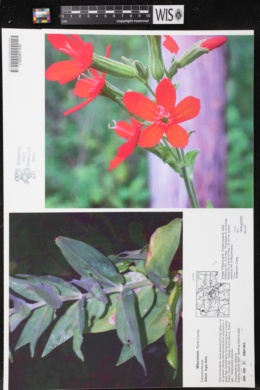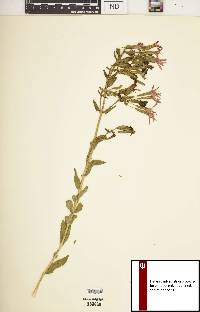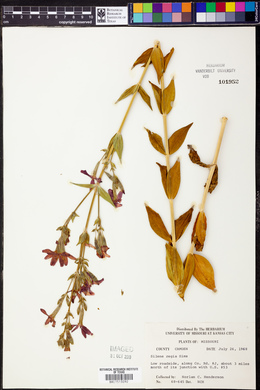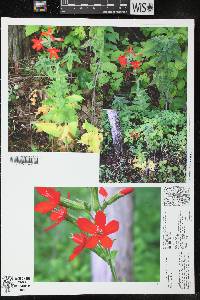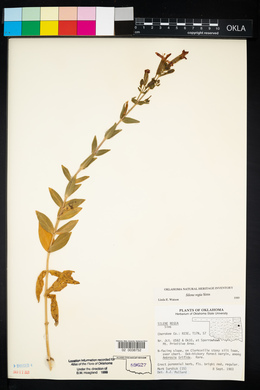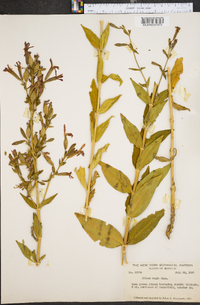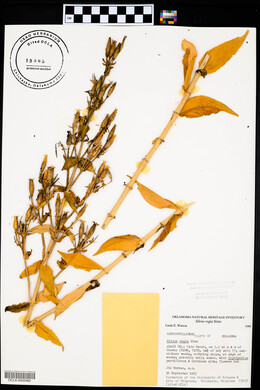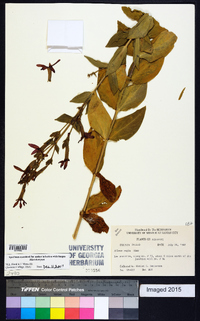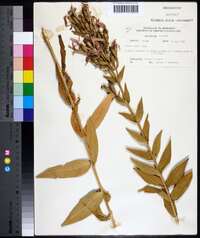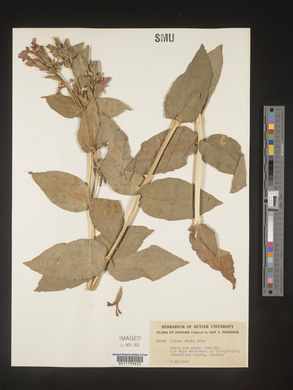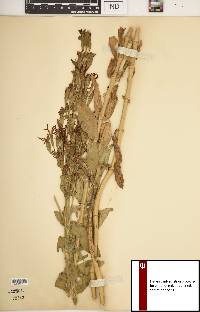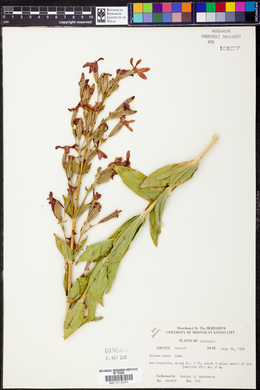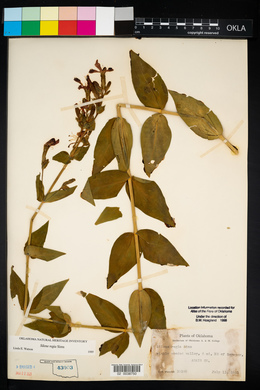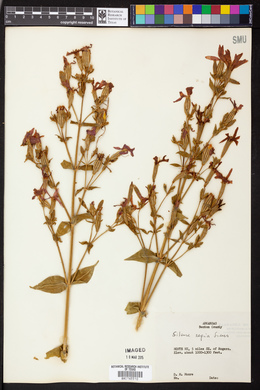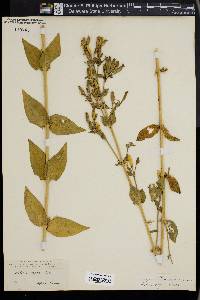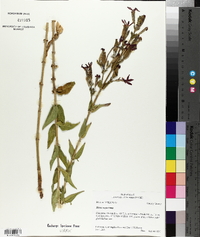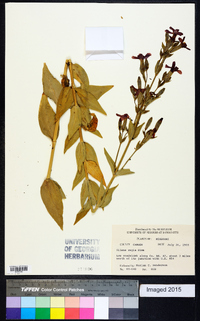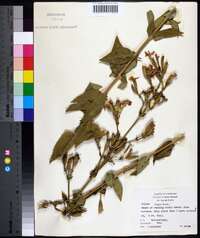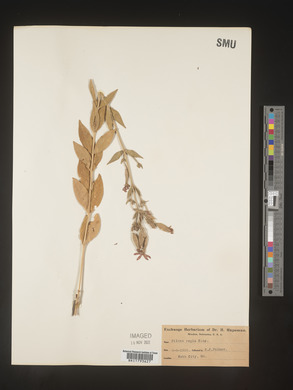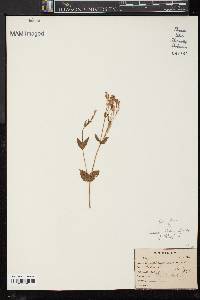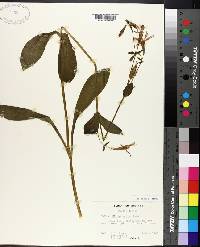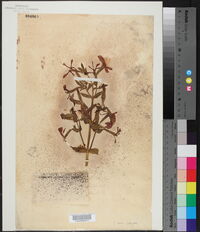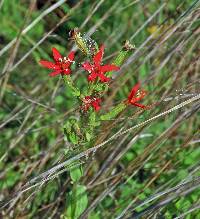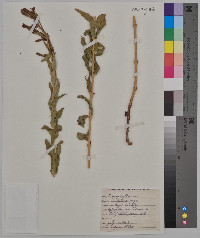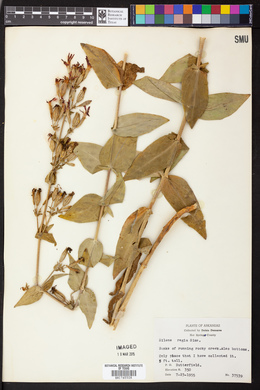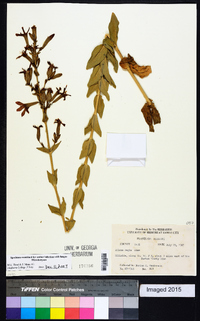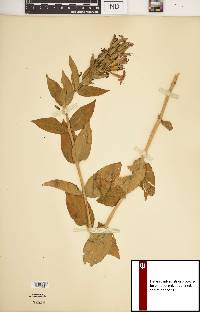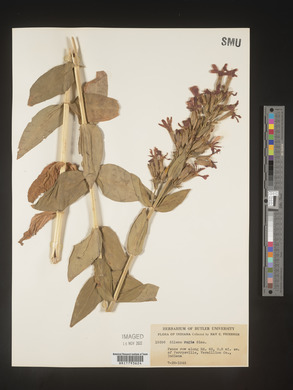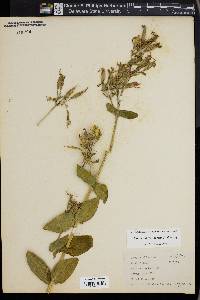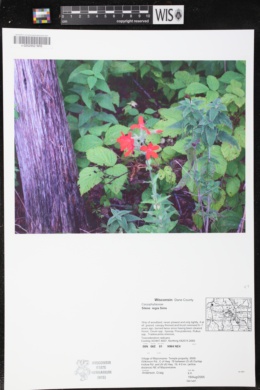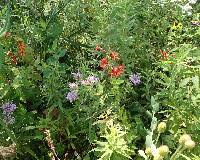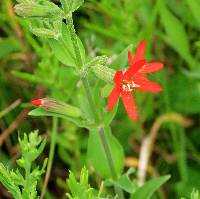Silene regia
|
|
|
|
Family: Caryophyllaceae
Royal Catchfly
|
Plants perennial; taproot stout, fleshy. Stems several, erect, simple proximal to inflorescence, 50-160 cm, glabrous to sparsely retrorse-puberulent proximally, more densely so and glandular distally. Leaves withered towards base at anthesis, in 10-20 pairs, sessile, gradually reduced distally; blade 3-veined, lanceolate to ovate, rounded into base, 4-12 cm × 20-50 mm, apex acute, not acuminate, glabrous to scabrous-puberulent adaxially, scabrous-puberulent abaxially. Inflorescences terminal, cymose, compound, many-flowered, bracteate, pedunculate, 15-25(-30) × 5-10 cm; bracts lanceolate, 3-30 mm; peduncle ascending. Pedicels 1-4 times longer than calyx, stipitate-glandular, puberulent. Flowers: calyx prominently 10-veined, tubular in flower, 18-25 × 3-4 mm, swelling in middle to 6-9 mm in fruit, umbilicate, constricted near base around carpophore, glandular-pubescent, especially on veins, veins green, lobes 2-4 mm, midrib lanceolate, margins often red tinged, broad, membranous; corolla scarlet, clawed, claw equaling calyx, limb oblong to elliptic, unlobed, rarely emarginate or shallowly 2-lobed, 10-20 × 5-6 mm, apex rounded, appendages 2, tubular, 2-4 mm; stamens exserted; styles 3(-5), exserted. Capsules ovoid-ellipsoid, narrowed at both ends, equaling calyx, opening by 6 (or 8 or 10) ascending teeth; carpophore 3-5 mm. Seeds dark reddish brown, reniform, 1.5-2 mm, with smooth and glossy, flat or concave sides, margins angled, shallowly rugose. 2n = 48. Flowering summer-fall. Dry prairies, rocky open woods, woodland edges and thickets; 100-400 m; Ala., Ark., Ga., Ill., Ind., Kans., Ky., Mo., Ohio, Tenn. Silene regia is a very distinct, spectacular species with tall stems, a narrow, many-flowered inflorescence, and bright red petals. It is probably related to S. laciniata via S. subciliata. Silene regia is in the Center for Plant Conservation's National Collection of Endangered Plants.
Perennial herb with a stout taproot 0.5 - 1.5 m tall Leaves: opposite, ten to twenty pairs, withering near base at flowering time, stalkless, 4 - 12 cm long, 1.5 - 7 cm wide, gradually smaller upward, lance- to broadly egg-shaped with a rounded base and pointed tip, three-veined, sometimes minutely hairy. Inflorescence: a terminal, compound, narrow cluster (cyme) of many flowers, 15 - 30 cm long, 5 - 10 cm wide, on an ascending stalk, subtended by bracts. Bracts leaf-like, 0.3 - 3 cm long, and lance-shaped. Flowers: scarlet. Stalk upright, one to four times longer than calyx, minutely hairy, glandular. Stamens ten, exserted. Styles three, exserted. Sepals: fused at the base into a tube (calyx). Calyx tube 1.5 - 2.5 cm long, 3 - 4 mm wide, swelling to 6 - 9 mm wide in fruit, tubular in flower, constructed near the base, indented (umbilicate), prominently ten-veined, glandular-hairy, with five short lobes. Lobes often tinged red marginally, 2 - 4 mm long, broad, membranous. Petals: five, scarlet, blade 1 - 2 cm long, 3 - 6 mm wide, blade oblong to elliptic with a rounded tip, narrowly clawed, more or less unlobed. Fruit: a dehiscent capsule, opening by six, eight, or ten ascending teeth, equal to calyx, egg-shaped to ellipsoid, narrowing at both ends. Seeds 1.5 - 2 mm long, dark reddish brown, kidney-shaped, with glossy sides, shallowly wrinkled. Stems: several, upright, sometimes sparsely minutely hairy below, more densely hairy and glandular above. Similar species: No information at this time. Flowering: mid-July to early August Habitat and ecology: Rare in the Chicago Region. Has been found along roads and railroads. Occurence in the Chicago region: native Etymology: Silene probably comes from the Greek word sialon, meaning saliva, referring to the sticky secretion on many of these plants. It may also have come from the word seilenos, referable to Silenus-a foam-covered, drunken character in Greek Mythology. Regia means royal. Author: The Morton Arboretum Taprooted perennial, 5-16 dm, glabrous to glandular-puberulent; cauline lvs 10-20 pairs, lanceolate to broadly ovate, 4-12 נ1.5-7 cm; infl narrow, compound, 1.5-3 dm, leafy-bracteate; cal tubular, 1.8-2.5 cm, glandular; pet crimson, the auricles prominent, the tubular appendages 2-4 mm, the narrowly oblong or elliptic, entire or irregularly denticulate blade 12-20 נ3-5 mm; carpophore 3-5 mm; styles 3; capsule dehiscent by 6 teeth; 2n=48. Prairies and open woods; O. to e. Mo., s. to Ala. and Ga. July. Gleason, Henry A. & Cronquist, Arthur J. 1991. Manual of vascular plants of northeastern United States and adjacent Canada. lxxv + 910 pp. ©The New York Botanical Garden. All rights reserved. Used by permission. From Flora of Indiana (1940) by Charles C. Deam A very local plant, mostly of a dry, prairie habitat. All of my specimens are from roadsides. It has been reported from Hamilton, Vigo, and Wayne Counties and the authors say that it is scarce. It has been reported from 3 counties of Ohio. …… Indiana Coefficient of Conservatism: C = 6 Wetland Indicator Status: N/A |
|
|
|

